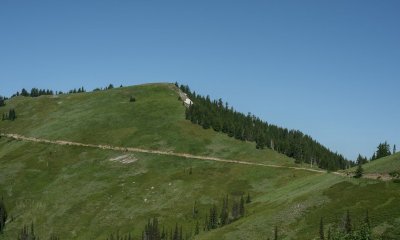
Subalpine Ashy Exposed Mountain Slopes 30-45" PZ Cryic Bitterroot Metasedimentary Zone
Circle-spoke model
Scenario model
Current ecosystem state
Select a state
Management practices/drivers
Select a transition or restoration pathway
-
No transition or restoration pathway between the selected states has been described
Target ecosystem state
Select a state
Description
Vegetation is typically forb-rich, with forbs often contributing more to overall herbaceous cover than graminoids. Tall forb-dominated mesic meadows are typically composed of a wide diversity of genera. At more subalpine elevations, Senecio triangularis, Erigeron peregrinus, Erythronium grandiflorum, Ligusticum species, Veratrum viride and Valeriana species are important forbs. Natural burrowing mammal disturbance regimes can increase forb diversity. Early successional stages may be dominated by Agastache urticifolia, Fragaria virginiana, Urtica dioica, Achillea millefolium, and other forbs, and small amounts of mesic grasses such as Bromus carinatus and Deschampsia cespitosa.
Submodel
Model keys
Briefcase
Add ecological sites and Major Land Resource Areas to your briefcase by clicking on the briefcase (![]() ) icon wherever it occurs. Drag and drop items to reorder. Cookies are used to store briefcase items between browsing sessions. Because of this, the number of items that can be added to your briefcase is limited, and briefcase items added on one device and browser cannot be accessed from another device or browser. Users who do not wish to place cookies on their devices should not use the briefcase tool. Briefcase cookies serve no other purpose than described here and are deleted whenever browsing history is cleared.
) icon wherever it occurs. Drag and drop items to reorder. Cookies are used to store briefcase items between browsing sessions. Because of this, the number of items that can be added to your briefcase is limited, and briefcase items added on one device and browser cannot be accessed from another device or browser. Users who do not wish to place cookies on their devices should not use the briefcase tool. Briefcase cookies serve no other purpose than described here and are deleted whenever browsing history is cleared.
Ecological sites
Major Land Resource Areas
The Ecosystem Dynamics Interpretive Tool is an information system framework developed by the USDA-ARS Jornada Experimental Range, USDA Natural Resources Conservation Service, and New Mexico State University.
